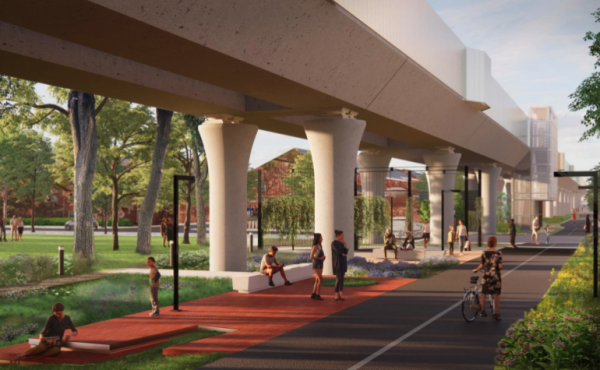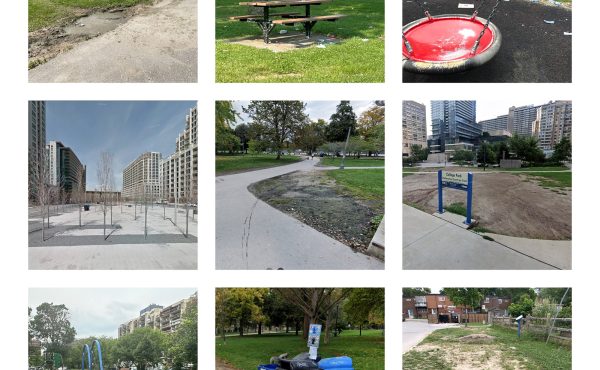
Here are a few links to articles in today’s papers:
The TTC is going shopping for new streetcars. The photo above, from Minneapolis, is the new breed of North American streetcars made by Bombardier. This is something that the TTC would consider, though the article notes that Toronto’s streetcars are special in some ways and will need specific modifications.
A company called Sub Media plans to install tunnel advertising in the Yonge subway line this fall, reports Metro News today. We have previously posted about subway tunnel advertising during the TVs on platforms and subway debate — I think you may know where we stand on this already. This new pilot project has not reached the TTC yet for public input, so we’ll try update any other info once we have it. We are waiting on some calls from TTC commissioners for comment.
Christopher Hume writes in the Star today about waterfront renewal in the St. Catherines area. “Toronto isn’t the only city with a waterfront. And it isn’t the only city with plans to bring its waterfront back to life. But here in Port Dalhousie, those plans may actually have a chance of being realized. Though the process has been rancorous, it will reach its conclusion when St. Catharines City Council votes on a $60 million to $70 million mixed-use scheme sometime in June.”
The widow of the Mississauga cyclist who died after falling off his bike, then a bridge, is campaigning to have the height of railings be raised on all overpasses. You can read about the memorial ride from this past weekend and some shots of the infamous bridge.
And Anthony Reinhert writes in the Globe and Mail today about the always contentious issue of dogs and parks. “Faced with a finite amount of parkland, relentless condo construction and a dog population between 250,000 and a half-million, city officials face a task that sounds more like herding cats — finding a way for all park users, dog lovers or not, to co-exist in peace. Later this spring, parks officials will present their best attempt at that goal — the Dogs in Parks Strategy, or DIPS — after more than a year of public meetings and research. It’s safe to expect the fur to fly.”




9 comments
Doesn’t DIPS also stand for The Development Infrastructure Policy and Standards, which calls for one-sidewalk streets?
Yes, you’re correct. Departments don’t talk to each other about acronyms, it seems.
Can we talk about the way dogs ruin the grass at Cawthra Park *every* year? Requiring it to be re-sodded *every* year?
Ideally these selfish dog owners wouldn’t be allowed to ruin parks the way they do, but at least they can clean up after their dogs. Having them forced to clean up after their pets would be a start.
One of the first things I noticed about parks and grass in Toronto is that I could not assume it was clean enough to sit on, as it was in Windsor, where there were more backyards and less apartment dwellers. So many dogs, so few places for them to do their business means all park space becomes a giant toilet.
I’m conflicted about dogs — I like them, and we always had one, but I’m not sure if they belong in the city.
Am I the only person in this city that thinks streetcars are a terrible waste of money?
-Maintaining the infrastructure
– maintaing streetcars themselves
– the traffic delays caused during the upgrades
– the problems caused whenever a streetcar has mechanical issues (Listen to a scanner and you’ll here this all the time),
– the traffic congestion caused by streetcars
-the danger to people getting on and off the streetcars
-obstruction caused by streetcar thoroughfares (ie St Clair controversy)
We should STOP using streetcars and replace each streetcar in the fleet with a hydrogen fuel cell (or other similar green technology ) buses. Buses don’t require tracks, they can go anywhere and route quickly around any obstruction. They do not alienate neighborhoods and they keep users safe by pulling up to the curb without having to spend millions on changing the way the roads work.
If I ran the city I’d pull the Streetcars off all their routes except for the places where right of ways already exist like St Clair, Spadina and Harbour front. The surplus SC’s could be put to use keeping those lines alive for years to come. The money saved would more then easily add green buses to streets like King and Queen, enough to cover the requirements during rush hour and more.
Please don’t talk to me about fuel cell buses. This chimera has been around for decades and is nowhere near coming to market. Indeed, hybrid buses are on the street now and have the advantage of using existing technologies.
However, if you really want to put buses on streetcar routes, get ready for lots of congestion. To handle the demand today on King Street (never mind the demand that will grow with new development) would require a bus roughly every 1’20”. If you think the roads are congested now, try filling them up with buses.
As for reconstruction, yes it’s been a mess. The TTC is nearing the end of a multi-year program to recover from decades of bad track construction. By the end of 2007, almost the entire system will have been rebuilt and the level of annual construction work will fall by over 50%.
The current crop of streetcars has a lot of problems caused by the fact that the electronics are old and almost impossible to replace, and in the best Toronto tradition we designed our own car rather than buying one off the shelf.
Decisions made two decades ago contributed to the changed public perception of streetcars: poor roads and lousy service were a function of bad planning and an anti-streetcar mentality within the TTC. Streetcars can provide excellent service and do so in many cities all over the world.
“Am I the only person in this city that thinks streetcars are a terrible waste of money?”
There are a few people out there, but they’re not really taken seriously.
-Maintaining the infrastructure
– maintaing streetcars themselves
Streetcars actually need less maintenance than buses, because like all electric vehicles, they take less punishment than combustion-based vehicles like diesel buses.
While a single streetcar costs more than a single diesel bus, they are not a terrible waste of money. A typical bus lasts twelve years without a rebuild. A typical streetcar lasts thirty years and vehicles have lasted fifty years or more with decent maintenance. A typical bus carries 75 passengers comfortably. A typical streetcar can comfortably handle 102 passengers. The King streetcar operates at crush capacity with streetcars scheduled to pass every two minutes during rush hour. To maintain the carrying capacity of King Street, you’d have to replace the 30 streetcars passing per hour with 40 buses. That wouldn’t reduce congestion or pollution, it would increase it.
Streetcars are expensive vehicles, but they are worth it because they last longer and carry more people. And the high cost is compared to pollution-spouting diesel buses. Hydrogen buses would be nice things to have, but they too will cost far more than the $750,000 required to purchase a 40 foot diesel bus.
– the traffic delays caused during the upgrades
Toronto’s streetcar-less roads have more traffic delays due to normal road work.
– the problems caused whenever a streetcar has mechanical issues (Listen to a scanner and you’ll here this all the time),
Even though the current fleet of streetcars is approaching the end of its design life, the number of mechanical problems in the fleet is small, compared to the hundreds of hours and thousands of route miles these streetcars ply every week.
– the traffic congestion caused by streetcars
This is an outright lie. As I cited above, replacing the King streetcar with buses would increase the number of transit vehicles on that road by 25%, and with those buses weaving in and out of traffic, rather than confined to the centre two lanes, the delays caused by buses are the same as a typical streetcar, especially given that you are required to yield to a bus entering traffic.
I’ve driven on King Street in a car during rush hour. Everything moves at the same speed. Streetcars aren’t contributing to the problem, and buses won’t solve it. And in every case where streetcars have been removed on city streets, traffic congestion has increased rather than decreased. This is due to an increase of traffic, but it shows that the traffic-blocking capabilities of streetcars are highly overblown. They certainly didn’t obstruct my car any more than any other car on any street without streetcars.
– the danger to people getting on and off the streetcars
Isn’t it strange that we don’t often hear about people getting hit by cars getting on and off the streetcars? That’s because it’s provincial law for car drivers to stop behind the rear doors of a streetcar when it approaches a transit stop. Failure to do this results in demerit points and a hefty fine. I have ridden on streetcars all my life, and have never been close to having an accident. And, in any event, safety islands as used on Queen’s Quay, Spadina, Carlton, Bathurst and St. Clair reduce the risk further. Getting off a streetcar is no more risky than crossing the street in this city.
-obstruction caused by streetcar thoroughfares (ie St Clair controversy)
The St Clair “controversy” is the result of a small but vocal minority that’s claiming to speak for a community that came out 3-1 in favour of the project.
It’s interesting to note that the TTC was planning to abandon its streetcar network as late as 1972. They were only backed off this foolish policy by the grassroots effort of Toronto citizens like Steve Munro. Streetcars are a part of Toronto’s cultural fabric, and we get good value out of them. For this reason, streetcars have returned or are on their way back in such cities as Edmonton, Calgary, Ottawa, Portland, Salt Lake City, Denver, Dallas, Houston and elsewhere. Toronto is ahead of the curve, and the expansion of the streetcar network into the suburbs will improve transit for all Torontonians for a fraction of the cost of new subway lines.
“Am I the only person in this city that thinks streetcars are a terrible waste of money?â€Â
I choose streetcar routes over bus routes at every opportunity. Streetcars are far more comfortable.
“So many dogs, so few places for them to do their business means all park space becomes a giant toilet.”
Other creatures that use park space as a toilet include: cats, bats, squirrels, mice, moles, racoons, shunks, deer, fox, groundhogs, people, pigeons, owls, crows, toads, frogs, snakes … dog poop, at least, can be scooped and put in your green bin!
Of course dogs belong in the city. People walking their dogs put ‘eyes on the street’, frequenting parks at times of day and during seasons when they’d be otherwise vacant.
Am I the only person in this city that thinks streetcars are a terrible waste of money?
I love how many conservatives in Toronto talk about how the TTC is a waste of money, and how they would love Toronto to act more like Calgary. Then their are those who believe Streetcars are only as replacements for buses.
Yet Calgary Transit, doesn’t build subways; We have used street car technology, and built a LRT line. They run mostly at grade on a right of way, except in downtown. They are as effective subways, but can be a hassle sometimes.
I think Streetcars are quite nice, give a great flavour to the city.